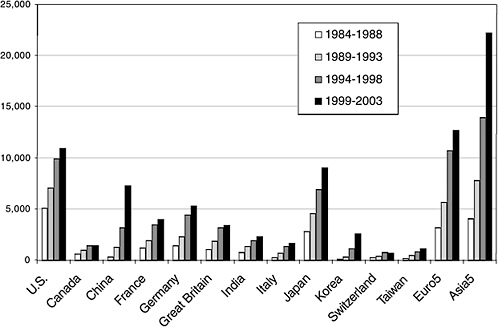D
Global Trends in Literature Authorship
Data were gathered from the Science Citation Index Expanded format.1 The article-title field of the database was searched for relevant words in each of the areas chosen and the number of articles found from each country recorded.
ALLOYS
Figures D.1 and D.2 show the literature data for the alloys subfield from 1984 to 2003. The global output of scientific papers has grown considerably in those 20 years, but while the number of papers from the United States has increased steadily, its share of the global numbers has decreased. The same is true for Japan, whereas the share of global output for the Euro5 and the Asia5 groups has steadily increased, as has their performance when matched against the United States—as shown in the top chart of Figure D.2. In particular, the output of papers with authors from China and Korea shows exceptional growth, with recent numbers from China approaching those of the United States and Japan and outstripping more traditional centers of R&D in countries like Germany, France, and Britain.
|
1 |
The Science Citation Index Expanded provides access to current and retrospective bibliographic information, author abstracts, and cited references in approximately 5,900 of the world’s leading scholarly science and technical journals covering more than 150 disciplines. For further information, see http://www.isinet.com/products/citation/scie/. |
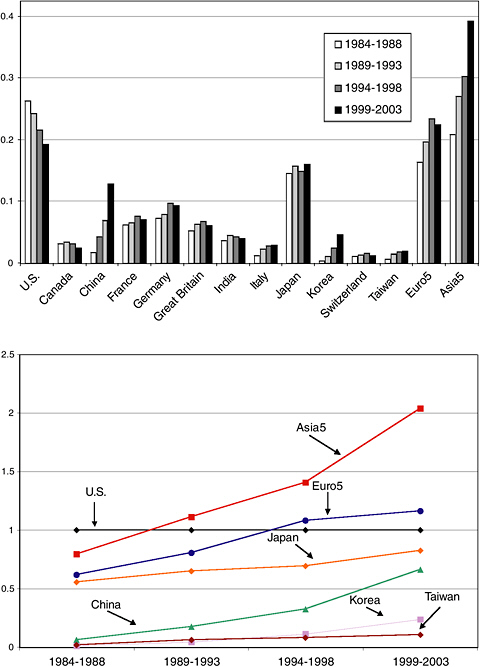
FIGURE D.2 Country of authorship for 20 years of literature (1984–2003) in the alloys subfield. The upper chart shows the share for each country as a fraction of the total number of papers for that time period. The lower chart shows the share factor normalized to the literature output of authors in the United States.
CATALYSIS
Figures D.3 and D.4 show general growth in the global output of literature in the subfield of catalysis over the 20 years. However, the data also show that despite the strong increase in the number of papers authored in the United States, the U.S. share of the global total declined somewhat after 1990. The United States does not enjoy any discernible and reliable lead in the catalysis field, although it is among the leaders. Japan’s share has remained steady, while the numbers from the Euro5 countries showed a small but discernible increase in the 1990s and some stagnation more recently. The Asian share of the literature output, however, shows a steady and strong increase over the 20 years, outstripping U.S. output from 1999 to 2003. China shows a particularly strong increase, surpassing the individual European countries and approaching Japan’s output. The increase has been significant for Korea but less so for Taiwan.
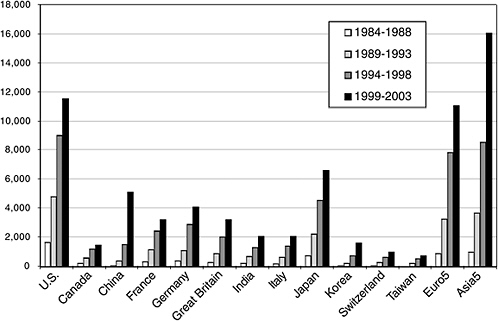
FIGURE D.3 Country of authorship for 20 years of literature (1984–2003) in the catalysis subfield. The chart shows the total number of papers for each country and for the Asia5 and Euro5 groups.
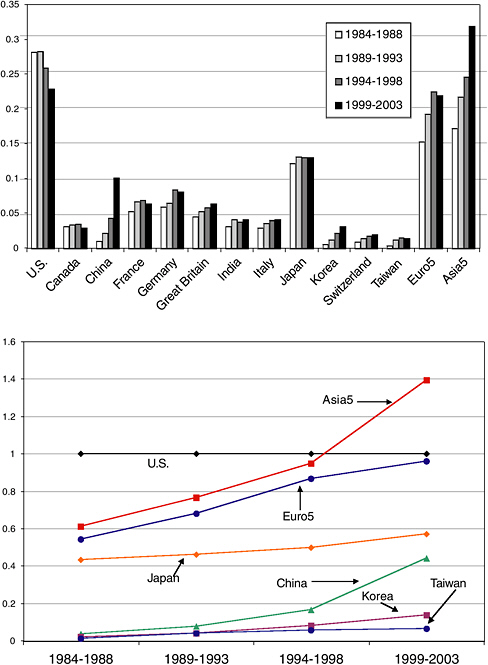
FIGURE D.4 Country of authorship for 20 years of literature (1984–2003) in the catalysis subfield. The upper chart shows the share for each country as a fraction of the total number of papers for that time period. The lower chart shows the share factor normalized to the literature output of authors in the United States.
COMPOSITE MATERIALS
The literature on composite materials flourished from 1984 to 2003 across the globe (Figures D.5 and D.6). The United States remains in the lead in terms of share of global total, but this leadership was challenged between 1999 and 2003 by the European and Asian regions. In Europe, Britain enjoys the lead, with Germany surging ahead to nearly equal the output from France or Britain. China’s share is approaching Japan’s, and significant increases can be seen in the output share for Taiwan and Korea, although the numbers are small.
OPTICAL-PHOTONIC MATERIALS
Data in Figures D.7 and D.8 show the United States maintaining its lead in literature over the 20-year period, but with the European and Asian regions approaching it over the last 15. Italy shows the strongest surge in Europe of the countries
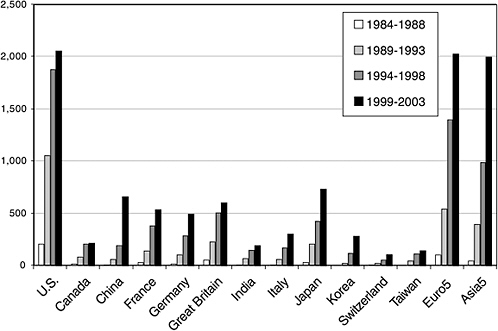
FIGURE D.5 Country of authorship for 20 years of literature (1984–2003) in the composites subfield. Chart shows the total number of papers for each country and for the Asia5 and Euro5 groups.
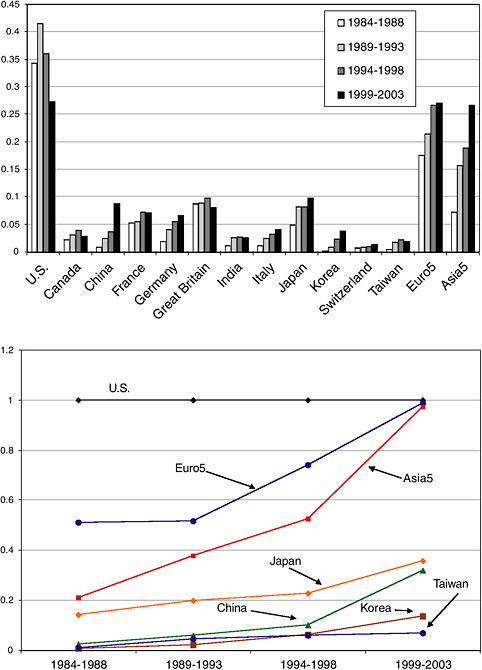
FIGURE D.6 Country of authorship for 20 years of literature (1984–2003) in the composites subfield. The upper chart shows the share for each country as a fraction of the total number of papers for that time period. The lower chart shows the share factor normalized to the literature output of authors in the United States.
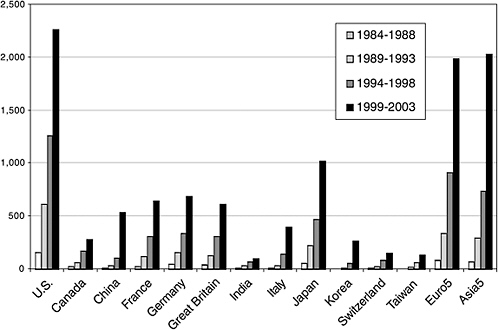
FIGURE D.7 Country of authorship for 20 years of literature (1984–2003) in the optoelectronics/ photonics subfield. Chart shows the total number of papers for each country and for the Asia5 and Euro5 groups.
measured. Japan’s share remains steady over the 20 years, while increases can be seen in China, Taiwan, and Korea, although they are not as strong here as in the other subfields.
GENERAL TRENDS IN GLOBALIZATION FROM LITERATURE DATA
Although there are differences between the various sets of data, some general trends emerge:
-
The United States is among the world leaders but not the clear leader in all four subfields.
-
Western Europe and Japan are also among the leaders in these subfields and showed clear surges in activity in the subfields from 1989 to 2003, overcoming previous U.S. dominance.
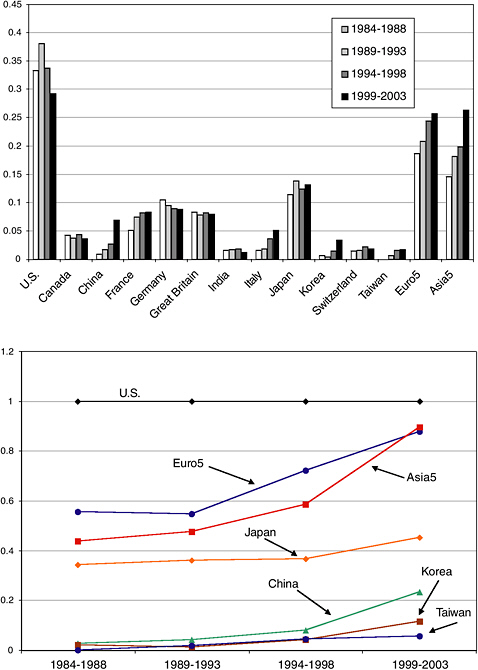
FIGURE D.8 Country of authorship for 20 years of literature (1984–2003) in the optoelectronics/ photonics subfield. The upper chart shows the share for each country as a fraction of the total number of papers for that time period. The lower chart shows the share factor normalized to the literature output of authors in the United States.
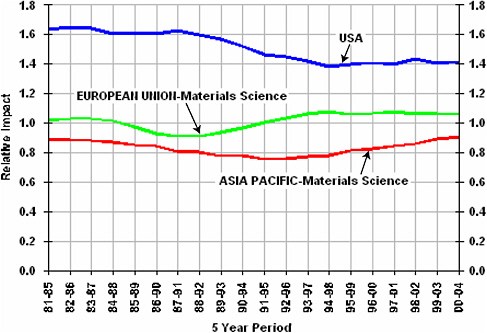
FIGURE D.9 Relative impact of materials science papers from the United States, the Asia-Pacific region, and the European Union. SOURCE: Thomson Scientific National Science Indicators, 1981–2004.
-
In all four subfields there has been a significant increase in the literature presence of the Asian countries included in these searches: Most notably, the number of papers from China increased substantially over the last 5 to 10 years, to levels at times approaching the number from Japan and several Western European countries.
-
The globalization of authorship in the world’s journals appears to be advancing rapidly, with a clear shift toward authors from countries that were not traditionally involved in these subfields.
With literature analyses, there is always a question about the quality of the papers being counted. Figure D.9 tries to ascertain the relative quality of the papers in materials science from 1981 to 2001 by counting the number of times a paper was cited. Like the preceding information, the figure shows that the U.S. lead in terms of citations has narrowed since 1980, with the Asia/Pacific region and Europe encroaching on traditional U.S. dominance.

